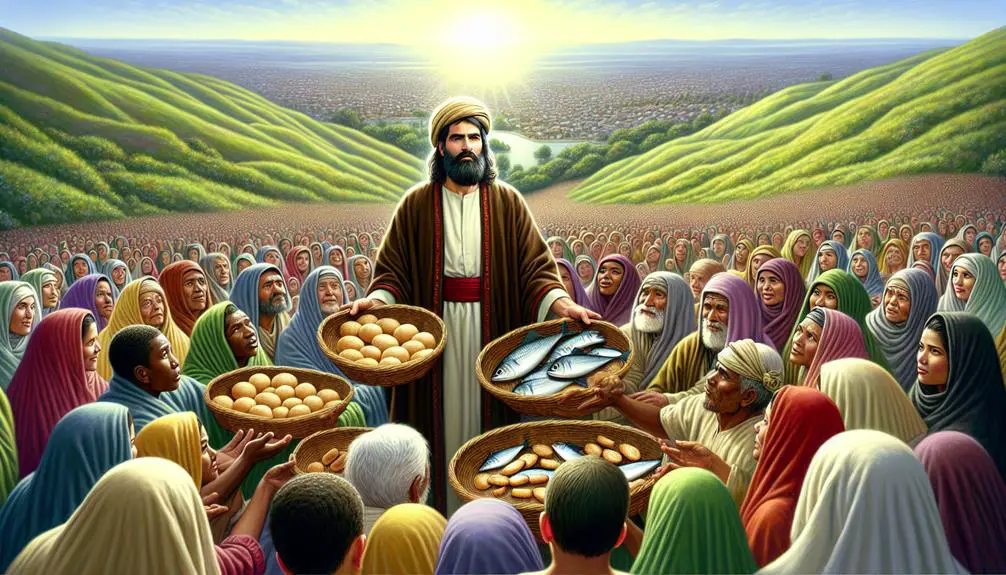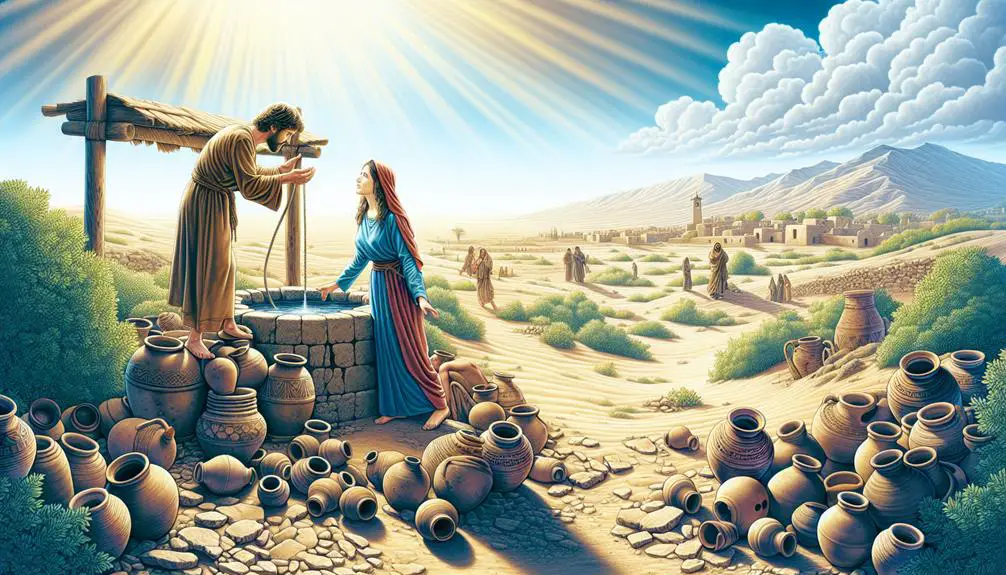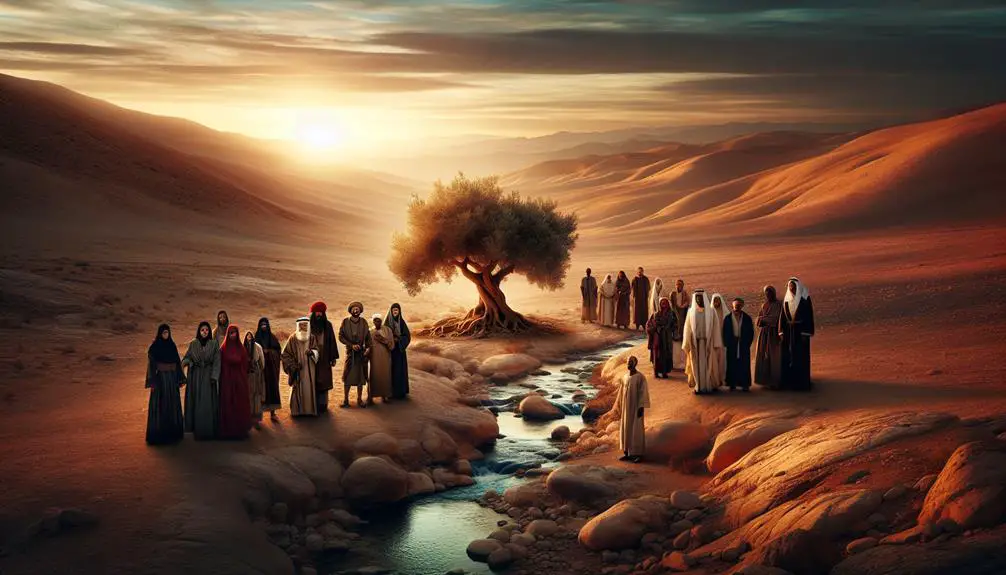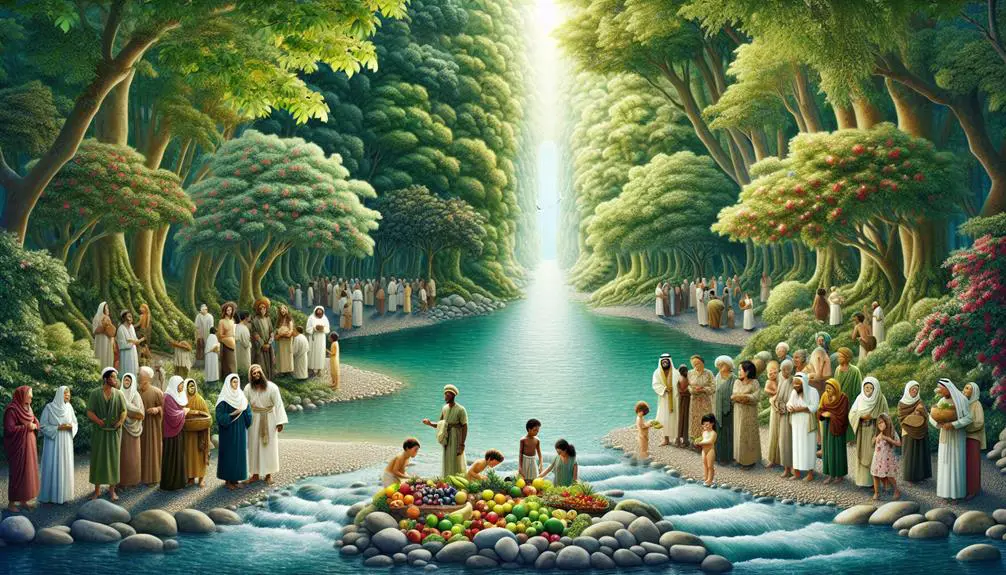Yearn to understand how hunger and thirst in the Bible reflect our deepest spiritual needs and God's enduring provision.

Hunger and Thirst in the Bible
In the grand tapestry of the Bible, hunger and thirst are not just recurring motifs; they're practically characters in their own right, driving narratives and teaching lessons that resonate through millennia.
As you explore these stories, from the miraculous manna in the Exodus to the profound encounter at the Samaritan well, you'll find that these themes do more than just illustrate physical needs—they symbolize deep spiritual longings and the divine response to human vulnerability.
The question now is, how do these ancient narratives speak to our modern lives, and what can they teach us about our own spiritual hunger and thirst?
Key Takeaways
- God's provision for hunger and thirst extends beyond physical needs, symbolizing spiritual nourishment and fulfillment.
- Hunger and thirst are metaphors for the human quest for meaning, addressed through a relationship with God and spiritual disciplines.
- Jesus embodies the fulfillment of spiritual hunger and thirst, offering eternal satisfaction through His teachings and the promise of the Water of Life.
- Fasting and prayer are vital spiritual practices that deepen one's reliance on God for sustenance, highlighting the importance of spiritual over physical nourishment.
The Exodus: Manna and Quail

In the midst of their desert journey, the Israelites faced dire hunger and thirst, yet God provided manna and quail to sustain them, a testament to divine provision and care. This narrative is pivotal in understanding desert survival through a lens of faith and reliance on divine provision. The manna, described as bread from heaven, and quail, provided in the evenings, underscore a profound reliance on supernatural sustenance in an environment notoriously unforgiving.
Analyzing this passage, it's evident that the provision of manna and quail wasn't merely about physical nourishment but also served as a spiritual lesson in trust and obedience. The manna, which appeared with the morning dew, required daily collection, except before the Sabbath, illustrating a rhythm of work and rest prescribed by divine command. This rhythm not only ensured physical survival but fostered a communal discipline anchored in faith.
Furthermore, the temporary nature of manna, which spoiled if kept beyond a day, except on the Sabbath, underscored the importance of reliance on God's daily provision. This aspect of the narrative invites a deeper reflection on the themes of trust, provision, and the transient nature of material sustenance in the face of divine constancy.
Jesus Feeds the Multitudes

Reflecting on the theme of divine provision in the desert, we now turn our attention to another profound biblical instance where hunger was met with miraculous supply: Jesus feeding the multitudes. This event stands as a testament to the power of faith and the depth of Jesus' compassion towards those who followed Him. With just a few loaves of bread and fish, Jesus demonstrated His ability to provide not just spiritually, but physically, for His people. The crowd's response to this miraculous provision was one of awe and affirmation of Jesus' identity as the Messiah.
Miraculous Provision |
Crowd Response |
|---|---|
Few loaves and fish |
Awe and wonder |
Multiplication |
Affirmation of faith |
Feeding thousands |
Recognition of Jesus as the Messiah |
Demonstrates Jesus' power |
Inspiration for followers |
Physical and spiritual sustenance |
Deepened faith and commitment |
This narrative encourages you to see beyond the physical act of feeding. It's an invitation to trust in divine provision, even when resources seem scarce. The crowd's response underscores a shift from mere physical satisfaction to a deeper, spiritual nourishment, pointing us toward the holistic nature of Jesus' ministry.
The Samaritan Woman at the Well

The encounter of Jesus with the Samaritan woman at the well serves as a pivotal narrative, highlighting Christ's breaking of societal barriers and His offer of living water as the ultimate satisfaction for spiritual thirst. This interaction, rich in theological and social implications, boldly addresses and dismantles the cultural barriers and gender norms of the time.
In your exploration of this narrative, you'll notice Jesus intentionally crosses cultural lines by engaging with a Samaritan, a group despised by Jews due to historical and religious conflicts. Furthermore, He challenges prevailing gender norms by speaking directly to a woman, an act that defies the social conventions of His era. This moment isn't just a casual conversation; it's a revolutionary act that illustrates Jesus' disregard for human-made divisions in favor of offering spiritual sustenance to all, regardless of their social standing or background.
Fasting and Prayer

Delving into the concept of fasting and prayer reveals its profound significance as a spiritual discipline that fosters a deeper communion with God. This practice, deeply embedded in biblical tradition, isn't just a mere abstention from food or drink; it's a deliberate act of faith that purifies the body and soul, making room for a more intimate encounter with the divine. By setting aside physical sustenance, you acknowledge your spiritual hunger and thirst, which only God can satisfy.
Fasting and prayer carry:
- Health benefits: Beyond spiritual purification, fasting has been linked to physical health improvements, such as enhanced metabolic function and reduced risk factors for diseases.
- Community impact: Collective fasting can strengthen community bonds, creating a shared experience that fosters empathy, support, and a unified purpose.
- Personal growth: This discipline challenges you to exercise self-control, deepens your spiritual insights, and cultivates a disciplined lifestyle conducive to growth in personal faith and communal responsibilities.
Through this prism, fasting and prayer emerge not only as acts of devotion but as transformative practices with far-reaching implications for both individual and community well-being.
The Beatitudes: Blessed Are the Hungry

You've encountered the Beatitudes, where 'Blessed are the hungry' underscores a profound spiritual principle.
This hunger isn't for the transient, but signifies a deep yearning for righteousness and divine fulfillment.
It promises that such spiritual longing will indeed be satisfied, offering a perspective that elevates the soul's desires above mere physical sustenance.
Spiritual Hunger Significance
Often, spiritual hunger operates as a profound metaphor within the Beatitudes, emphasizing a deep, insatiable yearning for righteousness and divine fulfillment. This metaphor extends beyond mere physical needs, pointing you towards a path of spiritual enlightenment and the quest for divine desires and soul nourishment.
- Divine Desires: Spiritual hunger signifies an intense longing to align with divine will, guiding you towards a life filled with purpose and moral integrity.
- Soul Nourishment: Just as the body craves food and water, your soul yearns for spiritual sustenance, available through prayer, meditation, and acts of kindness.
- Moral Integrity: This hunger fosters a commitment to living ethically, encouraging you to seek justice and practice compassion in your daily interactions.
Understanding these aspects enriches your spiritual journey, leading to a fuller, more meaningful existence.
Fulfillment Promises
In the Beatitudes, the promise of fulfillment to those who hunger and thirst for righteousness reveals a profound spiritual principle: true satisfaction comes from pursuing divine justice and holiness. This pursuit embodies the essence of divine provision and covenant fulfillment. You're called to a life where your deepest hungers are met not by worldly means, but through a steadfast commitment to God's righteousness.
Aspect |
Insight |
|---|---|
Divine Provision |
God's supply exceeds physical needs, touching the soul. |
Covenant Fulfillment |
Commitment to righteousness fulfills divine promises. |
Spiritual Hunger |
A longing for righteousness leads to divine satisfaction. |
Divine Justice |
Pursuing God's justice aligns with His kingdom principles. |
Holiness |
Holiness is both a pursuit and a gift from God. |
This table encapsulates how the Beatitudes guide you towards a life of fulfillment through divine provision and covenant fulfillment.
Revelation: The Water of Life

The Book of Revelation vividly introduces the concept of the Water of Life as a fundamental promise to those who persevere in faith. This divine provision represents eternal satisfaction, transcending the physical needs of hunger and thirst. It's a metaphorical depiction of the unending sustenance that faith in the divine promises. Through this imagery, Revelation encapsulates a profound theological truth: the fulfillment of the deepest human longings through divine means.
To delve deeper into this concept, consider these insights:
- The Water of Life is freely offered: It highlights the grace and generosity of the divine, emphasizing that this eternal satisfaction is a gift, not earned.
- Symbolism of purity and renewal: This water doesn't just quench thirst; it symbolizes purification and a new beginning, free from past transgressions.
- A promise of eternal presence: Beyond physical sustenance, the Water of Life signifies the eternal presence of the divine, offering comfort and assurance to believers.
Analyzing this imagery provides a rich understanding of the spiritual sustenance promised to believers, framing the Water of Life as a cornerstone of hope and renewal within the Christian faith.
Frequently Asked Questions
How Have Interpretations of Hunger and Thirst in the Bible Evolved Over Different Historical Periods or Within Various Christian Denominations?
You're exploring how interpretations have evolved over time or within different groups. It's fascinating to see how historical interpretation and denominational contexts shape understanding.
Each era and sect brings its unique perspective, infusing ancient texts with fresh insights. This journey through interpretations isn't just academic; it's a reflection of how beliefs and values shift.
You're delving into a rich tapestry of thought, where each thread is woven from distinct views on spiritual hunger and thirst.
Are There Any Lesser-Known Biblical Stories or Characters That Exemplify Spiritual or Physical Hunger and Thirst, Not Covered in the Major Stories Like the Exodus or Jesus's Miracles?
You're diving into ancient texts, like unearthing forgotten recipes in a grandma's attic, seeking stories that quench deeper curiosities.
Amid the well-known tales, Nabal's feast and the Manna mystery stand out, offering unique perspectives on spiritual and physical sustenance.
These narratives, less spotlighted, provide rich soil for analytical exploration, revealing how fundamental needs intertwine with faith and morality, enriching your understanding of historical and theological dimensions of hunger and thirst.
How Do Biblical Teachings on Hunger and Thirst Influence Contemporary Christian Practices or Social Initiatives Aimed at Addressing Food and Water Scarcity?
You'll find that biblical teachings on hunger and thirst deeply influence modern Christian practices, particularly in charity models and environmental stewardship. These principles encourage Christians to tackle food and water scarcity through active engagement in social initiatives, reflecting a commitment to serve the needy and protect God's creation.
This approach is rooted in a scholarly understanding of scripture, inspiring insightful actions that aim to address these critical issues in today's society.
In What Ways Do Biblical Metaphors of Hunger and Thirst Intersect With or Differ From Similar Metaphors in Other Religious Texts or Traditions?
You'll find that hunger and thirst serve as powerful metaphors across various religious texts, reflecting deep cultural symbolism and philosophical interpretations.
While the Bible employs these as symbols of spiritual longing, other traditions might liken them to the quest for enlightenment or moral purity.
Analyzing these parallels and differences, you'll uncover how each tradition uniquely harnesses these basic human experiences to convey profound spiritual truths and ethical teachings.
Can the Themes of Hunger and Thirst in the Bible Offer Insights Into Modern Psychological or Spiritual Conditions, Such as Emptiness or Longing, That Are Not Directly Related to Physical Needs?
You're exploring how deep yearnings for emotional fulfillment and spiritual awakening mirror the themes of hunger and thirst. These motifs transcend physical needs, delving into the realms of psychological and spiritual conditions.
They reflect a universal quest for meaning and connection, suggesting that the feelings of emptiness or longing you might experience can be interpreted as signals, guiding you towards personal growth and a more profound understanding of your place in the world.
Conclusion
In your journey through the biblical narratives of hunger and thirst, you've traversed from the tangible sustenance of manna and quail to the spiritual nourishment of the Water of Life. These stories serve as a tapestry, weaving physical need with spiritual longing.
They symbolize the profound truth that our deepest hungers and thirsts transcend the physical, pointing toward a craving for divine fulfillment. Thus, the Bible encapsulates an eternal truth: our souls seek sustenance beyond the corporeal, thirsting for the infinite.



Sign up